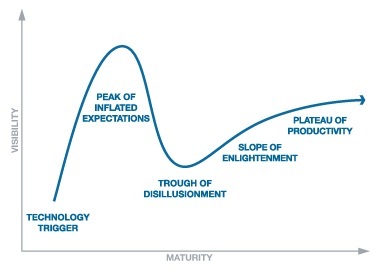Since 2013 very few things have matched the headline performance of the Internet of Things (IOT). In 2014 IOT went from being a visionary "trigger concept" of the future ( Gartner's Hype Cycle) to being categorized by some in 2016 as a key fixture of the "Trough of Disillusionment".
That is a fast path of evolution for this important technology trend that has been accompanied by all the requisite media buzz and flurry of investment activity. Next up for IOT is the "Plateau of Productivity". But before we witness this latest evolution, what are the milestones we need to reach before we make that shift a reality? In many ways one of the big hurdles for realizing the promise of IOT is something we already know and experience in our daily lives and holds the key to unlocking the full potential of IOT. I'm talking about maps.
Maps may not seem like an innovation to many. In reality,maps have been around in one form or another since the earliest days of human history. They have endured because fundamentally, they address the most basic of human instincts. Namely the need to define, explain, and navigate our way through the world. Fast forward to 2016 and it is exciting to realize then that the true promise of the Internet of Things to reshape and realize our lives and our connection with information is now at hand.
Why Context is King for the Intersection of IOT and Big Data
So much of what we now take for granted in our lives today has already formed the foundation for the emergence of an IOT transformation. This includes big data and its presence in the cloud along with an almost ubiquitous mobile computing and communication environment. Still what is lacking in making this all a truly "human and natural" experience is the context of time, person and place. To give us what can best be described as an enhanced ability to automatically anticipate the knowledge we specifically need based on where we are and who we are, without prompts or arbitrary measures. Simply put the intersection of all those considerations comes in a map that unlike earlier static versions, is dynamic and interconnected and personalized to the data that makes this context real. To be of real benefit, IOT platforms need to connect, communicate and collaborate.
Just think about it. We already have access to more information now than was even dreamed possible only a decade ago. With the advent of mobile, wearable and beaconing technology we are now more than ever able to add the layer of location-based information. What is needed now is a means to get more utility of data by dynamically integrating and connecting it with who we are and the time and place we occupy at any given moment. For example, do you care about information on what the price and availability of a product or service is when you're physically nowhere near it? For all of the advances we have made in our mobile society we still too often fall short of creating real value. For example, we now take the benefit of Google maps and its counterparts for granted, but too often the benefit of that map stops at the front doors of the building.
The Advent of Experiential Wayfinding
With the advent of Experiential Wayfinding, all of the benefit of maps can be made seamless both outside and inside the building. Let's face it, the places we are going to in our journey hold much more valuable experiences and information within their walls than outside them. "Experiential Wayfinding bridges the gap and makes navigation a truly three-dimensional map experience that dynamically combines knowledge of who you are and when you are with the location you are in both inside and outside a building" says Chris Wiegand, CEO of Jibestream. By automating information access and suggesting choice and options in context, the value of big data and IOT is made whole and gives us the extended ability to anticipate and dramatically improve our quality of life.
Creating Utility While Protecting Privacy
To some, the advent of this shift may sound intimidating. While many are fans of the type of experience once highlighted in the film Minority Report it is equally true that it implies a level of data knowledge and awareness that many consider an invasion of privacy. The difference between being empowered or threatened by this experience is at its root who controls the information access and how personal privacy is protected. The key to addressing this concern is in how the map captures, relates, communicates and shares data. The balance between the utility of access for information and the protection of privacy is something that any viable Experiential Wayfinding experience will need to include at a platform-design-level to be effective but protected. "This is not only possible butnow operational in many of the applications we operate for clients worldwide and is a matter of segmenting how data is associated and protected within the platform to preserve both anonymity and utility." Says Wiegand.
The Promise of IOT and Big Data Made Real
We live in a time when we laugh knowingly at the phrase "there's an app for that". In only a few short years it has gone from a novelty to an everyday reality. With the addition of the three-dimensional mapping platform of Experiential Wayfinding we are poised to enter a whole new era of innovation where the new phrase may well include "a map for every app". That future is now at hand and it is this intersection that will fundamentally change our ability to benefit from big data and the IOT and realize a better quality of life along the way.

